|
Your next vacation in space
|
 |
April 30, 2001: 11:46 a.m. ET
Companies have plans for space craft to make travel affordable in next decade
By Staff Writer Chris Isidore
|
NEW YORK (CNNfn) - Dennis Tito may be the first tourist in outer space, but a number of companies are hard at work raising money and even designing spacecraft to make sure he's not the last.
Space Adventures, a Virginia company that arranged Tito's flight Saturday to the International Space Station, has already taken 150 customers to 80,000 feet, just to the edge of the earth's atmosphere, where the darkness of space and the curvature of the earth are visible.
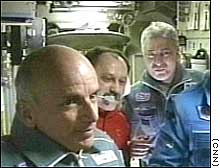
|
|
|
Dennis Tito, front left, aboard the International Space Station Monday. Tito paid about $20 million to the Russians to become the first tourist in space. | |
And within three years officials there think they can have a privately-built sub-orbital rocket that be able to take passengers on a trip to space similar to the first by U.S. astronaut Alan Shepherd 40 years ago for the relative bargain price of $98,000.
Another company, Space Island, is aiming even higher, looking to build a space station and a fleet of six new shuttles for $12 billion, and taking passengers to space for week-long trips by 2007. Other companies are also aiming at hotels in orbits and flights to the moon.
While these efforts are big, the companies aiming for them so far are small - Space Adventures has only eight employees, for example.
The major aerospace contractors, such as Boeing Co. (BA: Research, Estimates), are busy working on NASA's International Space Station and private satellite launches, and have announced no plans for their own ventures to bring members of the general public into space. Officials at Boeing did not return calls about the potential of space tourism or other space business.
| |
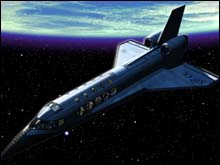
|
|
Space Adventures believes it can use a space craft like the one shown in an artist's drawing here to take people on a 25-minute flight to space for $98,000 within three years. (Courtesy: Space Adventures) | |
NASA, which strongly objected to Russia agreeing to take Tito to outer space, also refused to comment on the plans on the topic. Proponents of space tourism say the agency has been a tremendous obstacle to the public's access to outer space.
"Forty years after the Wright brothers, we had 3 million people making airplane flights," said David Gump, president of the Luna Corp., which is aiming to make the first landing on the surface of the moon since the end of the Apollo missions, albeit with an unmanned mission at first. "It's an unnatural thing we don't have space tourism now. But because Apollo was so successful no one ever questioned if America should have centrally-run government space effort."
Skepticism of the economics of space tourism
Critics of space tourism scoff at its potential and of its advocates' attacks on NASA. John Logsdon, professor at George Washington University and director of the school's Space Policy Institute, says the slower progress into space is because space flight is immensely more difficult than simple airplane flights.
|

|
VIDEO
|
|
 CNN's Matthew Chance reports from Moscow on Dennis Tito's space vacation. CNN's Matthew Chance reports from Moscow on Dennis Tito's space vacation. |
|
Real
|
28K
|
80K
|
|
Windows Media
|
28K
|
80K
|
|
He says the lack of success so far is a sign that advocates of space tourism are peddling pie in the sky dreams that are not economically practical.
"There has to be good economic reasons to make a trip and a destination," said Logsdon, who termed Tito's trip "high-tech bungee-jumping."
Tourist floating on air over visit to space station
Is there space travel in your future? Take a CNNfn poll
CNN.com's outer space coverage
Click here for a look at aerospace stocks
"You might tap an initial pool of people with lots of money and nothing better to do," said Logsdon about the plans for space tourism. "But you want to sustain it over 10 to 20 years." He said he doesn't believe the design plans for a low-cost reusable spacecraft being discussed are practical in the time frames proposed.
But even Logsdon said that long-term he does believe there will be affordable vacations in outer space for people besides millionaires like Tito.
"I think it's inevitable at some point in the future there will be public space travel, but I'd say it'll be 25 years, maybe 20 years."
C.J. Wallington, a professor at the Rochester Institute of Technology who teaches the nation's only course in space tourism, says that for space tourism to become economically viable he believes it will take government support. Tourism may also need the help of an alternative, non-vacation commercial use of space, such as micro-gravity manufacturing or drug research, to be economically and politically viable.
"It's not going to be developed real soon without government support," he said. "And even I don't want my taxes going just for tourism."
Businesses say pent-up demand for flights is there
But others say that tourism has to come first, that it's the only source of travelers and dollars that will make sense in as the non-governmental use of outer space gets underway. They say that is the way that air travel got started in this country, with pilots doing barn storming, taking average people for joy rides. Business travel by airplanes came decades later.
"Don't think about what's aviation is like in 2001. Think about aviation was like in 1904 or 1908, or after World War I, because that's where we are today," said Gregg Maryniak, executive director the X Prize Foundation.
His is a private group that is offering $10 million to the first privately financed group that can build at least a three-passenger vehicle that can fly to 100 kilometers, or just above the earth's atmosphere, and be ready for a second launch within two weeks.
| |
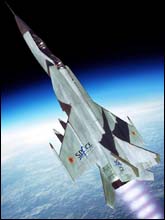
|
|
This composite photo shows the MiG25 jet reaching its highest point at the edge of the earth's atmosphere. Space Adventures is charging people $12,595 for the trip today. The photo shows the plane superimposed on a shot taken outside its cockpit during an actual flight. (Courtesy: Space Adventures) | |
Maryniak said there were only 25 commercial launches of satellites last year, and that is not going to grow rapidly, suggesting the business use of space is somewhat limited in the short-term.
But he pointed to surveys that show more than 60 percent of people in developed countries would buy a ticket for an outer space trip if they could. The price most of those would be willing to pay is between $15,000 to $20,000.
That's well below current costs, which come to about $10,000 per pound of payload. But Maryniak and others are convinced that private development efforts will break those price barriers.
"What we need to make the cost of going to space affordable is not technical innovation, it's a market," he said. "Twenty-five communication satellite launches is not much of a market. Tourism is the only thing that can immediately provide that market."
A survey from Space Adventures puts the cost most interested space travelers are willing to pay in the range of 30 percent of gross salary, with those who are less wealthy actually willing to pay a greater percentage of their current earnings.
The company's survey found 8 percent of those earning between $30,000 and $50,000 a year would be willing to take out a loan to pay the $98,000 price tag that Space Adventures hopes to be charging for a sub-orbital flight.
Larry Ortega, a former test pilot and the director of sales and marketing for Space Adventures, said that there are other candidates lined up behind Tito ready to buy a trip to outer space from the cash-starved Russians for $20 million. Potential travelers include two to three individuals and several corporations looking to buy the trip for an employee or customer.
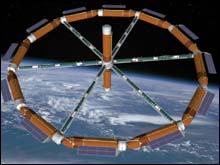
|
|
|
Artist's drawing of the proposed space station to be built out of empty shuttle fuel tanks. Space Island Group says it can build this station and a fleet of six shuttles and be flying passengers there for $1 million to $2 million each within seven years. (Courtesy: Space Island Group) | |
But he said the six months of training involved, the costs and limited opportunities don't make it a particularly good business model, and that the company is mostly focused on using the publicity around Tito's flight to raise investment and sponsorships for other offerings.
He's confident the company can build on the lower-cost offerings it has already, and those it has in the works. For $12,595 it can arrange the flight in the MIG-25 at two-and-a-half times the speed of sound to the edge of the atmosphere, although the plane can only stay at that point for about 90 seconds.
For $5,400 the company can arrange flights in a specially configured cargo plane that can go into the parabolic arc that simulates weightlessness for those inside.
All those offerings are in Russia, using Russian equipment, but the company is now raising money to bring those experiences back to the United States, as well as building a centrifuge to simulate the extra gravity of launch or reentry and a zero-buoyancy pool to allow customers to don space suits and practice space walks.
A trip to space for less than $100,000?
The key goal is to work with two different teams that are competing for the X prize. Ortega believes whichever one produces the most economically viable design will give it the vehicle it needs to start the 25-minute, 400 mile sub-orbital flights to outer space. And he's convinced there are millions of people in the world eager to pay its $98,000 price tag for such a ride.
"We make a billion with every 10,000 of them. That's a business," he said, saying the company's revenues last year came to about $1.2 million, expected to hit $5 million this year.
But he believes that even more revenue, and profits, are possible when greater capacity allows it to drop its price even further.
"It's very obvious to us as we drop this down into the $25,000 to $20,000 range, we make an awful lot of money."
That model of greater profits through greater capacity is also what's driving the plans of Space Island Group, which said it believes it can redesign the shuttles using modern, lower-cost components and other improvements to cut the cost from the $1.2 billion that NASA paid for the most recent one to about $300 million each, with its shuttles designed to carry 75 to 100 passengers rather than the current cargo bay.
| |

|
|
Artist's drawing of what the inside of Space Island's space station would look like. (Courtesy: Space Island Group.) | |
"The original shuttles were prototypes," said Gregg Meyers, founder and president of Space Island. "I compare them to concept cars that automakers spend hundreds of thousands on to take to car shows. These
shuttles would be real production models."
He said his group isn't asking for any financial support from NASA, just the access to some of the technology. He said he believes NASA would be willing to work with his group, rather than try to block it, and that his plans are not a criticism of the agency's performance.
"Asking NASA to operate a profitable venture is like asking a race horse to plow a field," he said. "Developing a space shuttle is a huge investment and there's no payback for investors."
Series of space stations seen
The other key to the company's plans is to use the external fuel tanks that the shuttles already carry into orbit to build a series of space stations. Those tanks were originally planned for that purpose but never utilized that way. They are now discarded during each flight to burn-up in earth's atmosphere.
Meyers says they have ample space to provide both tourism facilities and manufacturing uses. Each of its stations would be 50 times the size of the International Space Station. He estimates the first would be ready for residents by 2007, and that the initial price tag would be $1 million to $2 million for a week-long trip to space. But as the company continues to build more shuttles and more space stations, he said the price will continue to drop so that by 2012 he anticipates charging only $25,000 for a couple to visit for a week.
Meyers said his company already has investment commitments of $15 million in place, and anticipates having secured $500 million by the end of the year.
Plans for inflatable space stations
Another plan for privately financed space stations is being developed by Bigelow Aerospace, which sees using a Kevlar-like substance as the outside skin of a module that is inflated once it is in orbit.
Robert Bigelow said the design was first developed for use by NASA, but the agency cancelled plans in recent cutbacks. Bigelow says he's confident he has the resources at hand to develop the module and have it ready for testing within two years, at a fraction of the cost of the International Space Station. He believes demand for both tourist and business use of the facility will quickly make it economically viable.
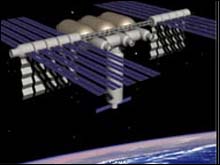
|
|
|
Artist's drawing of the planned space station using inflatable modules planned by Bigelow Aerospace. (Courtesy: Bigelow Aerospace) | |
He said he's not surprised that it is smaller, privately held companies that are working on facilities for taking civilians to outer space, rather than the major aerospace concerns.
"Boeing and Lockheed are scared. They also don't want to get cross-wise with NASA, and NASA has sent the message to those companies that it views outer space as its monopoly," Bigelow said. "Those companies also have a history of being risk averse to put up their own capital when they don't have a government program to support them. This is very risky. The commercial aircraft business is very predictable compared to the aerospace."
But Bigelow and some other space entrepreneurs compare the chances of the upstart outer space companies to the companies that pioneered the personal computer.
"All those guys should not have had a chance when there was IBM sitting there, dominating the computer industry, but they did it," Bigelow said.
For the companies aiming to take passengers to outer space in the coming years, raising the money is a daunting challenge, although one they believe will be helped by Tito's flight.
"When Apple Computer got started, they couldn't raise money to save their soul because nobody could imagine what they were doing," Space Adventure's Ortega said. "Now they can see the potential that's out there." 
|
|
|
|
|
 |

|

